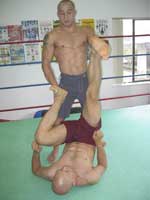
by Denis Kang and Stephan Kesting
Originally published in Grappling Magazine, October 2005
Denis Kang knows all about passing the guard in mixed martial arts competition. He has fought in Japan and throughout North America, and has passed the guards of many good fighters, including Minoru Suzuki, Keith Rockel and Stephan Potvin. He knows that passing the guard is one of the hardest things to do in a fight, but also that it is one of the most important skills to master.
Almost all No Holds Barred matches have one or both fighters using their guards at some point. If you end up in your opponent’s guard he has 5 basic strategies, the so-called ‘5 S options’ of guardwork:
- Stall
- Stand up
- Submit you
- Sweep you
- Strike you
Does your fight strategy include responses to all five scenarios? One of the best things you can do to negate his options is to improve your position by passing his guard. Once you have passed his guard he is far less dangerous to you and it is much easier for you to administer punishment and/or hunt for a submission.
 |
Leg swing guard pass |
|---|
Guard passing is a multi-stage process. If your opponent is using a closed guard (i.e. his ankles crossed behind your back) then you first have to open his legs. Once his legs are open you have to establish some sort of control over his hips and legs, and then finally you have to pass over, under or around his legs. Typically, but not always, successful NHB guard passes end up in side mount.
One effective way to force an opponent to open his closed guard is to stand up and punch him. Most fighters, faced with a barrage of punches from above, will open their legs in order to push you away or to kick you from below. Another way to open his guard is to control his body with the use of your grips and then pry his legs open using your hands, elbows or knees. This approach is often difficult in NHB because there just aren’t very many secure or reliable grips available without a gi, but we are going to show you how to accomplish this regardless!
Once his legs are open you don’t want to give him any offensive options. Standing up is a valid tactic: this greatly reduces his ability to apply upper body submissions (but watch out for footlocks and kneebars)! If you choose to stand you have to carefully manage the distance between you and your opponent: too far away and you give him the opportunity to stand up, too close and you may expose yourself to a damaging pedal kick! Keeping your hands on his feet or shins at all times is a good way to reduce his options and keep yourself safe – with his feet held it is difficult to kick with power, stand up or apply most techniques.
 |
Arm behind back pass |
|---|
When you have established control over his legs or hips, even momentarily, you can start your guard pass. Fundamentally there are 3 kinds of guard passes: you can pass over, under or around his legs. In NHB you most often pass over or around the legs.
Passing under his legs, although a valid tactic in Brazilian Jiu-jitsu and submission grappling, is rare in the wild world of NHB. Under-the-leg passes are typically slow and methodical, relying on tight grips and a crushing energy. Slipperiness and striking can make these types of passes difficult. A common guard pass in submission wrestling, for example, is the double underhook pass (where you place both your arms under your opponent’s legs). In a match with striking, however, attempting this guard pass is a good way to lose some teeth! Your face is exposed and neither arm is available for blocking punches.
Mix up your guard passes with striking, so that your opponent won’t know what to expect. This will make you unpredictable and keep him guessing. When you decide that the moment is right for your guard pass go for it with full commitment. Speed is important for most NHB guard passes, especially for those guard passes that start standing.
 |
Knee slide guard pass |
|---|
When you do finally pass your opponent’s guard take a second to stabilize your position: keep your hips low, get your arms and legs into the correct position, etc. Fighters commonly are so eager to strike or submit their opponents immediately after a guard pass that they make mistakes and end up back in guard or bridged over. Once you have the position stabilized you can then proceed to punish your opponent, looking for that KO strike or final submission. Good hunting to you!
Other Denis Kang Resources:
MMA Cross Training – a Denis Kang Profile
My MMA with Denis Kang – Instructional DVD


